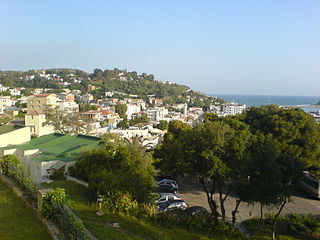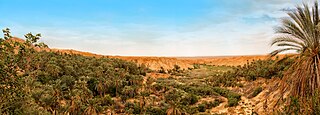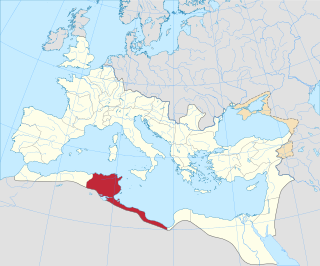
Tozeur is a city in southwest Tunisia. The city is located northwest of Chott el Djerid, in between this Chott and the smaller Chott el Gharsa. It is the capital of Tozeur Governorate. It was the site of the ancient city and former bishopric Tusuros, which remains a Latin Catholic titular see.

Tabarka is a coastal town located in north-western Tunisia, close to the border with Algeria. Tabarka was occupied at various times by Punics, Greeks, Romans, Arabs, Genoese and Ottomans. The town is dominated by an offshore rock on which there remains a Genoese castle. Nationalist leader Habib Bourguiba, later president of post-independence Tunisia, was exiled on Tabarka by the French colonial authorities in 1952. Tourist attractions include coral fishing, the Coralis Festival of underwater photography, and its annual jazz festival.

The Catholic Church in Scotland overseen by the Scottish Bishops' Conference, is part of the worldwide Catholic Church headed by the Pope. After being introduced through Iona Abbey and firmly established in Scotland for nearly a millennium, the Catholic Church was outlawed following the Scottish Reformation in 1560. Throughout nearly three centuries of religious persecution, several pockets in Scotland retained a significant pre-Reformation Catholic population, including Banffshire, the Hebrides, and more northern parts of the Highlands, Galloway at Terregles House, Munches House, Kirkconnell House, New Abbey and Parton House and at Traquair in Peebleshire.

The Archdiocese of Cape Town is a Latin Church ecclesiastical jurisdiction or archdiocese of the Catholic Church located in Cape Town, in the south-western region of South Africa. The principal church of the archdiocese and the location of the archbishop's cathedra is the Cathedral of St. Mary of the Flight into Egypt, which also serves as the patron saint for the archdiocese.

Mesarfelta was a Roman–Berber town in the province of Numidia. It was also a bishopric that is included in the Catholic Church's list of titular sees.

Negrine is a town and commune in Tébessa Province in north-eastern Algeria. It was the site of ancient Casae Nigrae, a settlement of Roman North Africa with an attached bishopric that remains a Latin Catholic titular see.

Vazari-Didda or Vazari Didda) was an Ancient city and bishopric in Roman Africa, which remains a Latin Catholic titular see.
Ksar-El-Kelb is an archaeological site in Tebessa, Algeria. It existed in the Roman province of Numidia and is highly believed to be the location of the Ancient city and former bishopric of Vegesela in Numidia, which remains a Latin Catholic titular see.

Vegesela in Byzacena was a Roman Era town tentatively identified with ruins at Henchir-Recba in modern Tunisia. The town was in the Roman province of Byzacena.

Bagai was a Roman–Berber city in the province of Africa Proconsularis. It must have been of some reasonable size, as it was also the seat of an ancient Catholic bishopric. The ancient city has been identified with ruins at Ksar-Bagaï outside of Baghai, in the Aurès Mountains of the El Hamma District in Khenchela Province, Algeria.

Turuzi was an ancient city situated in the Roman province of Africa Proconsularis. Its exact location is now lost to history, but it was somewhere in northern Tunisia.
Henchir-Khachoum is a locality and series of archaeological sites in Sidi Bouzid Governorate modern Tunisia. The ruins are strewn along a tributary of the Oued El Hatech river east of Sbeitla. During the Roman Empire there was a Roman town of the Roman province of Africa Proconsularis, called Muzuca, one of two North African towns to bare that name.

Uzzipari was a Roman town of the Roman Empire during late antiquity. An exact location for the town has been lost to history although that it was in the Roman province of Africa Proconsolaris means it must have been in northern Tunisia.

Zarna was a Roman town of the Roman Empire during late antiquity. An exact location for the town has been lost to history, although that it was in the Roman province of Africa Proconsolare means it must have been in northern Tunisia.

Migirpa was an ancient Roman-Berber civitas in the province of Africa Proconsularis. It flourished from 30 BCE to 640 CE. The town is identified as stone ruins near Carthage, Tunisia.
Asellicus of Tusuros was a 4th-century bishop of Tusuros, a Roman Town in what was Roman North Africa. He is known for being outspoken at the Council of Carthage of 411 and from a number of epistles with Augustine and Donatian of Reims.

Ksour-El-Khaoua is a locality in southern Tunisia, North Africa. During the Roman Empire the town was a civitas (town) in the Roman province of Byzacena. and the seat of an ancient Christian bishopric.

Feradi Minor was an ancient town in the Roman province of Africa proconsularis in the Sahel region of Tunisia. During late antiquity it was in the province of Byzacena.
The Diocese of Sita was a Christian diocese in Africa Proconsularis. It is presently a titular see of the Roman Catholic Church.

Marazanae was a Roman town of the Roman province of Byzacena during the Roman Empire and into late antiquity.









